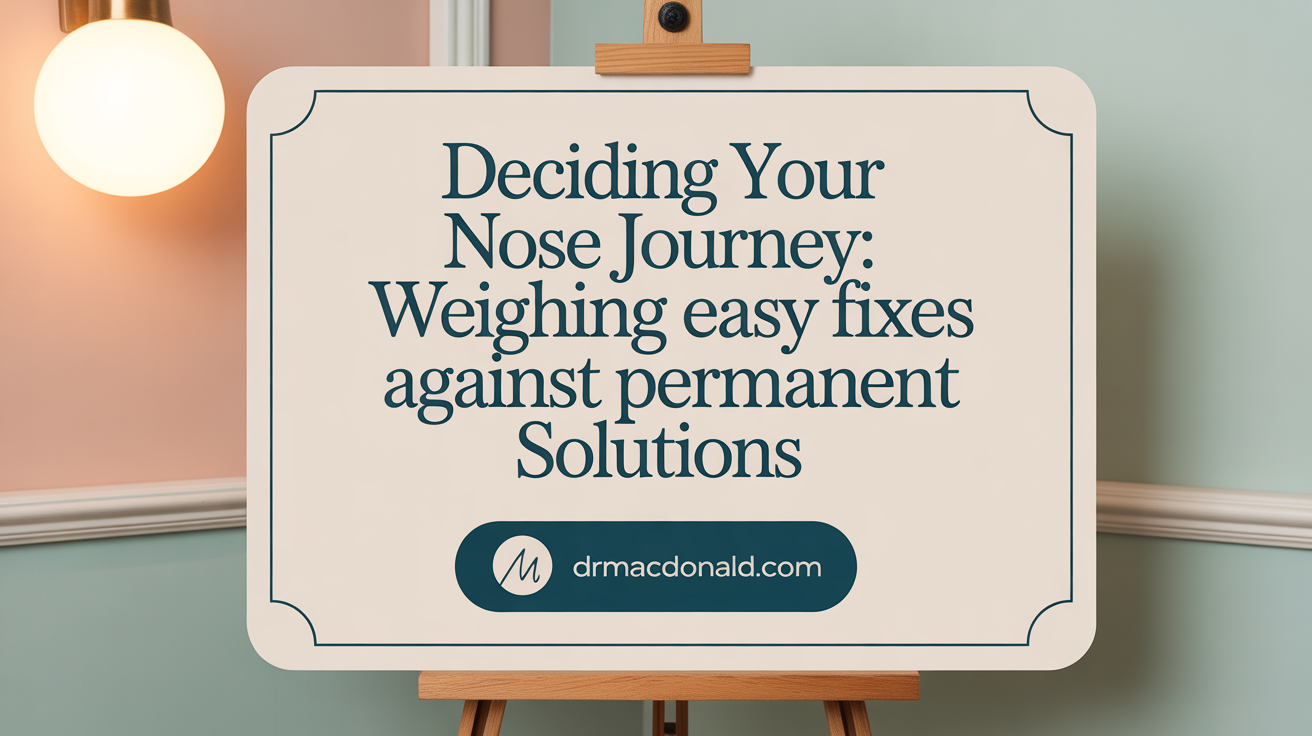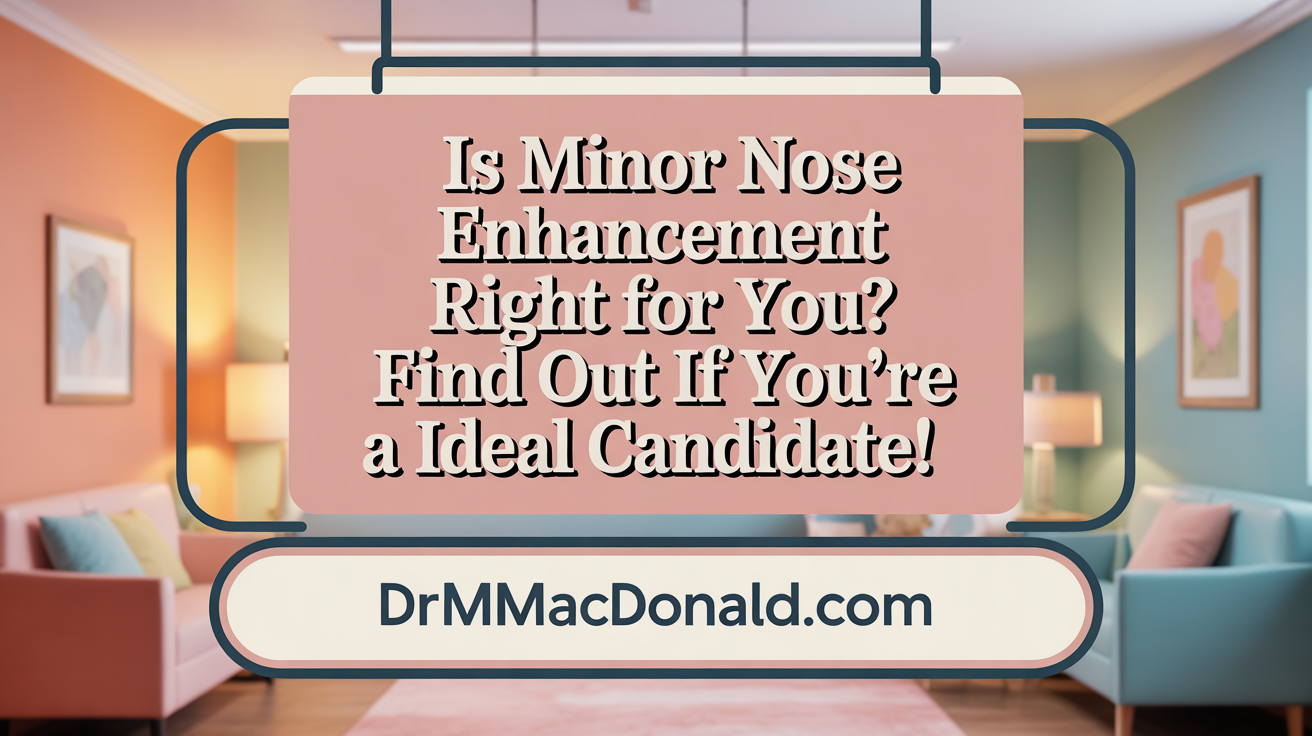Understanding the Modern Choices for Nose Enhancement
When considering nose enhancement, individuals today have the choice between traditional surgical rhinoplasty and the less invasive liquid rhinoplasty. Both procedures aim to improve nasal aesthetics and, in some cases, function, but they differ markedly in approach, results, risks, costs, and recovery. This article will guide you through these differences to help you make the most informed decision based on your cosmetic goals, health considerations, and lifestyle.
What Is Liquid Rhinoplasty and How It Compares to Traditional Surgical Rhinoplasty
What is liquid rhinoplasty and how does it differ from traditional surgical rhinoplasty?
Liquid rhinoplasty, also known as non-surgical or liquid nose job, is a cosmetic procedure that involves injecting dermal fillers—primarily hyaluronic acid—into specific areas of the nose to improve its shape and contour. The goal is to smooth bumps, elevate the nasal bridge, refine the tip, or correct minor asymmetries without any surgical incisions.
The main difference between liquid rhinoplasty and surgical rhinoplasty lies in the procedure and results. Surgical rhinoplasty is an invasive operation that reshapes the nose by modifying bone, cartilage, and skin. It requires anesthesia, longer recovery time, and results are permanent. This procedure can address complex issues, including major size reduction or correcting significant deformities.
In contrast, liquid rhinoplasty is quick, minimally invasive, and offers immediate visible results, usually in about 15 to 30 minutes. It’s perfect for those seeking minor, temporary adjustments. Because it uses hyaluronic acid fillers, the results are reversible; if a patient is unhappy, a healthcare professional can dissolve the filler with hyaluronidase.
While surgical rhinoplasty is suitable for substantial changes and structural corrections, liquid rhinoplasty offers a non-permanent, cost-effective alternative for subtle improvements. It generally lasts from 6 months to 2 years, depending on individual factors, and can be repeated as needed.
Use of hyaluronic acid fillers
Hyaluronic acid is a naturally occurring substance in the body known for its ability to hold moisture and add volume. It’s commonly used in various cosmetic procedures because of its safety and effectiveness. During liquid rhinoplasty, instances like Restylane or JUVÉDERM are injected to enhance nasal shape and symmetry.
Temporary vs permanent results
Results from liquid rhinoplasty are temporary, lasting anywhere from 6 months up to 2 years. This allows patients to test out new looks before committing to permanent surgery. Conversely, surgical rhinoplasty provides lifelong results, making it preferable for those seeking more dramatic, permanent changes.
Typical duration and quick procedure
The procedure is fast—typically completed within 15 to 30 minutes—and involves minimal downtime. Most patients can resume daily activities immediately afterward. This convenience and quick turnaround make it a popular choice for busy individuals or those trying it out for the first time.
Reversibility of liquid rhinoplasty
One significant advantage of using hyaluronic acid fillers is that the procedure is reversible. If patients dislike the results or experience complications, hyaluronidase can be injected to dissolve the filler, restoring the nose to its previous appearance.
Scope of corrections each can achieve
Liquid rhinoplasty is best suited for minor corrections: smoothing bumps, camouflaging asymmetries, elevating a flat or drooping tip, and filling indentations. It cannot reduce the overall size of the nose or correct significant structural issues—these require traditional surgical rhinoplasty.
| Aspect | Liquid Rhinoplasty | Surgical Rhinoplasty | Details |
|---|---|---|---|
| Procedure type | Non-invasive, injectable fillers | Invasive, surgical procedure | Surgery involves incisions and reshaping bone/cartilage |
| Results | Temporary | Permanent | Longevity varies; |
| 5-20 months for fillers, lifetime for surgery | |||
| Recovery | Immediate return to normal activities | 1-2 weeks downtime | Swelling and bruising are greater with surgery |
| Cost | $600 - $1,500 per session | $5,000+ | Surgical costs are usually higher |
| Ideal candidates | Minor imperfections, want quick fix | Significant structural changes | Based on desired outcomes and needs |
By understanding these differences, patients can choose the most suitable procedure based on their goals, budget, and the extent of change desired.
Benefits and Limitations: Choosing Between Non-Surgical and Surgical Rhinoplasty

What are the benefits and limitations of liquid rhinoplasty compared to surgical rhinoplasty?
Liquid rhinoplasty, also known as a non-surgical nose job, offers a quick, minimally invasive way to make minor improvements in the appearance of the nose. Using hyaluronic acid fillers, it provides immediate results that last between 6 to 18 months. The procedure takes about 15 to 30 minutes, involves minimal downtime, and is easily reversible with hyaluronidase if needed. It is especially effective for correcting small bumps, lifting a drooping tip, or refining nasal symmetry.
However, this approach has its limitations. It cannot change the overall size of the nose or correct structural deformities, such as wide nasal bones or severe asymmetries. It also does not address breathing issues or functional concerns. Since the results are temporary, ongoing treatments are necessary to maintain the desired look, which could increase long-term costs.
In contrast, surgical rhinoplasty provides a permanent and more comprehensive solution. It involves reshaping the nasal bones and cartilage to achieve significant aesthetic changes, like reducing a hump, narrowing the nose, or correcting deformities. It can also improve nasal function, such as airflow or breathing capabilities. Despite being more invasive, with a longer recovery period of about one to two weeks, the results are lasting and generally cannot be reversed.
Choosing between these options depends on individual goals. If minor adjustments are desired with minimal downtime, liquid rhinoplasty is the preferred option. For substantial, permanent changes or correcting structural issues, surgical rhinoplasty remains the best choice. Patients should consult with a qualified specialist to determine the most suitable approach based on their specific needs, expectations, and health considerations.
Risks and Side Effects: What You Should Know Before Treatment

What are the risks and side effects associated with liquid rhinoplasty?
Liquid rhinoplasty, a minimally invasive procedure using dermal fillers such as hyaluronic acid, generally has a low risk profile. Most common side effects are mild and temporary, including swelling, redness, tenderness, and minor bruising. These usually resolve within a few days.
However, serious but rare complications can occur. Vascular occlusion, where filler unintentionally blocks blood vessels, happens in approximately 0.35% of cases. This can lead to tissue necrosis or, in extremely rare situations, blindness if arteries around the nose and eyes are affected. The occurrence of skin necrosis is about 0.08%, and vision loss is reported in around 0.09% of procedures.
These severe risks arise when fillers enter the blood vessels, blocking blood flow to tissues or the eyes. Prompt recognition and treatment, typically with the injection of hyaluronidase to dissolve the filler, are crucial to prevent long-term damage.
Serious but rare complications
While most adverse effects are temporary, serious complications demand immediate medical attention. Filler migration or intravascular injection can cause skin necrosis, discoloration, or irreversible visual impairment. In extremely unlucky cases, these events could result in permanent scarring or disfigurement.
Risks associated with surgical rhinoplasty
Unlike non-surgical options, surgical rhinoplasty carries different risks, including bleeding, infection, scarring, and potential anesthesia reactions. Recovery involves a longer downtime, usually around 1-2 weeks, with swelling and bruising typical during that period.
Surgical procedures are also more invasive, with an increased chance of asymmetry and the need for revision surgery if results are unsatisfactory. However, surgical rhinoplasty provides permanent, structural changes and addresses both aesthetic and functional issues, such as breathing problems.
Importance of qualified professionals
To minimize these risks, it’s vital to have the procedure performed by a licensed, experienced plastic surgeon or dermatologist specialized in facial injections. They are trained to understand facial anatomy thoroughly, reducing the chance of vascular complications. Proper injection techniques and careful assessment of individual anatomy are essential for safety.
Contraindications and safety considerations
Liquid rhinoplasty is not suitable for individuals with a history of blood clotting disorders, allergies to fillers, or those prone to vascular problems. Patients should disclose their full medical history to their provider.
Post-procedure, patients must follow all care instructions and avoid blood-thinning medications before treatment to reduce bleeding risks. Regular follow-up visits ensure early detection of any adverse effects.
In conclusion, while liquid rhinoplasty offers immediate, reversible enhancements with minimal downtime, awareness of potential complications underscores the importance of choosing qualified practitioners and understanding individual safety considerations.
Who Should Consider Liquid Rhinoplasty? Profiling the Ideal Candidate

Candidate suitability for liquid rhinoplasty
An ideal candidate for non-surgical (liquid) rhinoplasty is someone looking to make minor, surface-level improvements to their nose without undergoing invasive surgery. These individuals usually have mild concerns such as small bumps, asymmetries, or a slightly drooping or bulbous tip.
Types of nasal imperfections addressed
Liquid rhinoplasty is effective in smoothing out bumps, augmenting a flat nasal bridge, lifting the nasal tip, and improving overall symmetry. It can help camouflage minor irregularities and fill indentations, providing a more balanced appearance.
Realistic expectations
Patients should have a clear understanding that results are temporary, lasting roughly 6 months to 2 years depending on the filler used. Since the procedure cannot reduce the overall size of the nose or correct significant deformities, those seeking drastic changes should consider surgical options.
Contraindications such as breathing issues
This procedure is not suitable for individuals with active nasal infections, breathing problems, or structural deformities requiring correction. Those with severe nasal deformities, deviated septums, or functional issues should consult with a specialist for surgical treatment instead.
Comparison with candidates for surgical rhinoplasty
Unlike surgical rhinoplasty, which offers permanent and more extensive reshaping, non-surgical rhinoplasty targets subtle adjustments and provides immediate, short-term results. Candidates for liquid rhinoplasty are generally younger, in good health, and seeking minor cosmetic enhancements rather than major structural changes.
| Aspect | Liquid Rhinoplasty | Surgical Rhinoplasty | Difference |
|---|---|---|---|
| Purpose | Minor, temporary shape correction | Major, permanent reshaping | Duration and scope |
| Ideal for | Gentle bumps, asymmetries, tips, and bridges | Significant deformities, size reduction | Extent of correction |
| Recovery time | Immediate to a few days | Weeks, with longer downtime | Speed of recovery |
| Main risks | Filler migration, vascular complications | Infection, bleeding, anesthesia risks | Nature of risks |
| Longevity | 6 months to 2 years | Permanent | Duration of results |
| Cost | $450 - $1,100 per session | Approx. $5,000 (varies) | Financial investment |
| Suitability for | Minor, cosmetic adjustments | Extensive structural changes | Candidate profile |
In summary
Candidates best suited for liquid rhinoplasty are those who desire subtle, temporary improvements to their nose. They should understand the limitations of the procedure and have realistic expectations about the results, focusing on minor adjustments in a quick, minimally invasive way.
Longevity, Costs, and Recovery: Evaluating Practical Considerations
How long do the results of liquid rhinoplasty typically last?
The effects of liquid rhinoplasty usually last between 6 to 18 months, with some patients experiencing results up to two years. This variability depends largely on the type of filler used—most commonly hyaluronic acid-based products like JuvedermiD or Restylane—and individual metabolic rates that influence how quickly the body absorbs the filler. Patients often notice immediate improvements following treatment, but these gradually diminish as the filler is naturally metabolized. To maintain their desired look, many choose to undergo repeat treatments every 6 to 12 months. Overall, the typical duration spans around 9 to 12 months, making it suitable for temporary adjustments or for those testing final looks before considering permanent surgical options.
What are the costs and recovery times associated with liquid versus surgical rhinoplasty?
Liquid rhinoplasty is significantly more affordable than its surgical counterpart. The cost typically ranges from a few hundred to several thousand dollars per session. In the US, the average expense is about $5,500, though costs can vary based on location and provider. The procedure is quick, often completed in under 30 minutes, with patients able to resume most daily activities immediately afterward. Minor swelling and bruising might occur but usually resolve within a day or two.
In comparison, surgical rhinoplasty is pricier, with average costs around $7,600 in the US, and can go up to $15,000 or more depending on the complexity and geographical area. Recovery from surgery is more demanding, requiring 1 to 4 weeks of downtime for swelling and bruising to subside. It involves a longer healing process because of incisions, reshaping tissues, and remodeling the nose's structure. Surgery offers permanent and more comprehensive reshaping but at a higher cost and longer recovery period.
Choosing between the two depends on individual goals: liquid rhinoplasty provides quick, less expensive, temporary results with minimal recovery, ideal for minor corrections. Surgical rhinoplasty, while more costly with extended healing, offers durable, significant structural changes for those seeking long-term solutions.
Making the Right Choice: Factors to Consider When Selecting Your Procedure
When deciding between liquid rhinoplasty and traditional surgical rhinoplasty, it’s important to evaluate your personal goals and expected outcomes.
If your main concern is minor imperfections, such as small bumps, asymmetries, or a slightly drooping tip, non-surgical options might suffice. Liquid rhinoplasty provides quick, minimally invasive results with immediate effects, making it appealing for those seeking subtle enhancements without downtime.
However, it’s crucial to set realistic expectations. Non-surgical rhinoplasty results are temporary, lasting approximately 6 months to 2 years, and it cannot decrease the overall size of the nose or correct significant structural deformities.
The primary difference lies in the purpose and scope of each procedure. For functional issues like breathing difficulties or major reshaping—for example, reducing a prominent dorsal hump or correcting a crooked nose—surgical rhinoplasty is more appropriate. It offers permanent, structural changes that cannot be achieved with fillers.
Consulting with a qualified, experienced surgeon is essential. A detailed medical assessment ensures that the chosen procedure aligns with your facial anatomy, health history, and aesthetic goals. An expert will also guide you through potential risks and expected recovery times.
In some cases, combining procedures or planning long-term strategies may be beneficial. For example, many patients start with a non-surgical approach to preview results or make minor adjustments before opting for surgical corrections later.
Here is a summary of the benefits and limitations of each option:
| Procedure | Longevity | Ideal for | Limitations | Risks |
|---|---|---|---|---|
| Liquid Rhinoplasty | 6 months to 2 years | Minor imperfections, asymmetries, subtle enhancements | Cannot reduce nose size or correct major deformities | Minor swelling, bruising, rare vascular complications |
| Surgical Rhinoplasty | Permanent | Major reshaping, structural corrections, functional issues | Longer recovery, higher cost, scarring | Infection, anesthesia risks, longer downtime |
Ultimately, your choice depends on your specific concerns, how permanent you desire the results, and your willingness to undergo recovery.
For comprehensive guidance, search terms like "choosing between liquid and surgical rhinoplasty" can provide further insights into which procedure best suits your needs.
Choosing the Best Approach for Your Nasal Enhancement
Deciding between a non-surgical liquid rhinoplasty and traditional surgical rhinoplasty depends largely on your individual needs, cosmetic goals, budget, and tolerance for downtime. Liquid rhinoplasty offers a quick, minimally invasive way to temporarily refine nasal contours with immediate results and minimal recovery, ideal for subtle flaws and those hesitant about surgery. Surgical rhinoplasty, while requiring a longer recovery and higher investment, provides permanent and comprehensive reshaping, addressing both aesthetic and functional issues. Consulting with a qualified specialist can help tailor the right procedure for you, ensuring realistic expectations and the safest, most satisfying outcome in achieving your desired nasal appearance.
References
- Liquid Rhinoplasty Vs. Surgical Rhinoplasty: Pros and Cons
- Liquid vs Surgical Rhinoplasty Explained - The Naderi Center
- Nonsurgical Rhinoplasty (Nose Job): What It Is, Uses & Procedure
- Traditional vs. Liquid Rhinoplasty | Jackson, MS | Faces
- Surgical Rhinoplasty vs Non Surgical Nose Job - Kensington Medical
- Liquid Rhinoplasty vs. Surgical Rhinoplasty - Florida Plastic Surgery
- Discover Non-Surgical vs Traditional Rhinoplasty Costs
